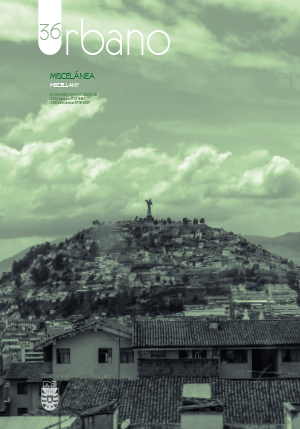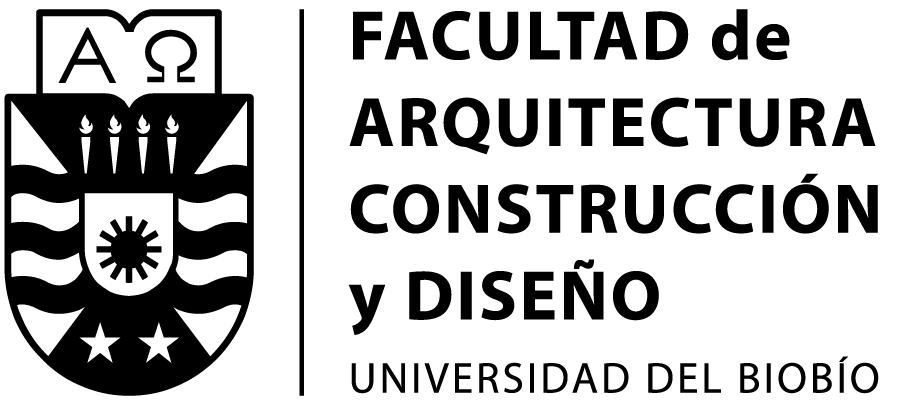Identificación de patrones espaciales del borde urbano mediante mapas Auto-Organizados de la centralidad de la red viaria.
DOI:
https://doi.org/10.22320/07183607.2017.20.36.02Palabras clave:
áreas suburbanas, inteligencia artificial, mapas, morfología urbana, infraestructura vialResumen
La caracterización morfológica del borde urbano es un ejercicio que reviste un interés especial porque, por una parte, ayuda a entender los crecimientos urbanos que tienen lugar en las zonas periféricas y, por otra, permite descifrar las claves de las relaciones de continuidad o discontinuidad que existen entre la ciudad y su entorno. En este contexto, son muchos los enfoques desde el análisis. En este artículo, se exploran en concreto las posibilidades que ofrece la utilización de mapas auto-organizados, elaborados a partir de los resultados de la aplicación de medidas de centralidad de la red viaria mixta que forman los sistemas de calles, los viarios metropolitanos y los caminos agrarios. La aplicación de diferentes medidas de centralidad en una red viaria mixta, supone en sí un ejercicio innovador, ya que, normalmente, los análisis de centralidad se aplican en el ámbito más puramente intraurbanos. La base espacial de los perfiles obtenidos en las series se puede comparar con la naturaleza del propio borde. La Metodología propuesta se ha testeado en la ciudad de Granada (España), específicamente, sobre el borde de contacto de la ciudad con el entorno de la Vega de Granada, un paisaje agrario singular ligado al Río Genil.
Descargas
Citas
ABARCA-ALVAREZ, Francisco Javier y FERNANDEZ-AVIDAD, Ángel. Generation of downtown planning-ordinances using self organizing maps. 10th International Conference on Design and Decision Support Systems, DDSS 2010. S.l.: s.n., pp. 63-79. 2010. ISBN 9789068141818.
AGRYZKOV, Taras; TORTOSA, Leandro y VICENT, José F. New highlights and a new centrality measure based on the Adapted PageRank Algorithm for urban networks. Applied Mathematics and Computation, 2016, 291, pp. 14-29. http://dx.doi.org/10.1016/j.amc.2016.06.036
ANTROP, Marc. Why landscape of the past are important for the future. Landscape and Urban Planning, 2005, 70 (1-2), pp. 21-34. http://dx.doi.org/10.1016/j.landurbplan.2003.10.002
ANVIDA, Analysis and Data Visualization in Net. [Consultado junio 2016] Disponible en: www.anvida.es
BRANDES, Ulrik; ROBINS, Garry; MCCRANIE, Ann. y WASSERMAN, Stanley. What is network science?. Network Science, 2013, 1 (1), pp. 1-15. http://dx.doi.org/10.1017/nws.2013.2
CHOAY, Françoise. Pour une anthropologie de l’espace. Éditions du Seuil, 2006.
CHRISTALLER, Walter. Central Places in Southern Germany. New Jersey: Prentice Hall, 1966.
CLÉMENT, Gilles. Manifiesto Del Tercer Paisaje. Barcelona: Gustavo Gili, 2007.
COHEN, Jacob. Statistical Power Analysis for the Behavioral Sciences. S.l.: Lawrence Erlbaum Associates, Publishers. 1998. ISBN 0-8058-0283-5.
DIAPPI, Lidia, BOLCHIM, Paola y BUSCEMA, Massimo. Improved Understanding of Urban Sprawl Using Neural Networks. En: J.P. VAN-LEEUWEN y H.J.P. TIMMERMANS (eds.), Recent Advances in Design and Decision Support Systems in Architecture and Urban Planning. Politecn Milan, Dept Architecture and Planning, I-20133 Milan, Italy.: Springer, pp. 33-49. 2004. ISBN 1-4020-2408-8.
DUANY A., PLATER-ZYBERK E. SmartCode 9.2. The Town Paper Publisher, 2003.
GEDDES, Patrick. Ciudades en evolución. Oviedo: KrK, 2009.
HAGGET, Peter y RICHARD, Chorley. Network analysis in Geography. London: Edward Arnold, 1972.
HAMAINA, Rachid, LEDUC, Thomas y MOREAU, Guillaume. Towards Urban Fabrics Characterization based on Buildings Footprints. En: J. GENSEL (ed.), Bridging the Geographic Information Sciences. S.l.: s.n., pp. 231-248. 2012. ISBN 978-3-642-29063-3. Disponible en: http://dx.doi.org/10.1007/978-3-642-29063-3_13.
JIANG, Bin. A topological pattern of urban street networks: universality and peculiarity. Physica A: Statistical Mechanics and its Applications, 2007, 384 (2), pp. 647–655 http://dx.doi.org/10.1016/j.physa.2007.05.064
KASKI, Samuel y KOHONEN, Teuvo. Exploratory Data Analysis By The Self-Organizing Map: Structures Of Welfare And Poverty In The World (1996). Neural Networks in Financial Engineering. Proceedings of the Third International Conference on Neural Networks in the Capital Markets, 1996, pp. 498-507. DOI 10.1.1.53.3954. Disponible en: http://citeseerx.ist.psu.edu/viewdoc/summary?doi=10.1.1.53.3954.
KOHONEN, Teuvo. Self-organized formation of topologically correct feature maps. Biological Cybernetics, 1982, [en línea], vol. 43, no. 1, pp. 59-69. ISSN 0340-1200. DOI 10.1007/BF00337288. Disponible en: http://link.springer.com/10.1007/BF00337288.
KOHONEN, Teuvo. Self-Organizing Maps. S.l.: Springer. 1995. ISBN 9783642852152. Disponible en: http://www.springer.com/cn/book/9783642976100.
KRAFTA, Rômulo. Fundamentos del análisis de centralidad espacial urbana, Centro-h, 2008, 2, pp. 52-72.
LÄMMER, Stefan; GEHLSEN, Björn y HELBING, Dirk. Scaling laws in the spatial structure of urban road networks. Physica A: Statistical Mechanics and its Applications, 2006, 363, pp. 89–95 http://dx.doi.org/10.1016/j.physa.2006.01.051
LATORA, Vito y MARCHIORI, Massimo. A measure of centrality based on network efficiency. New Journal of Physics, 2007, 9 (June), pp. 1-12. http://dx.doi.org/10.1088/1367-2630/9/6/188
LIU, Yaolin; WANG, Huimin; JIAO, Limin; LIU, Yanfang; HE, Jianhua y AI, Tinghua. Road centrality and landscape spatial patterns in Wuhan Metropolitan Area, China. Chinese Geographical Science, 2015, 25 (4), pp. 511-522. http://dx.doi.org/10.1007/s11769-015-0749-y
MASUCCI, A. Paolo; SMITH, Duncan; CROOKS, Andrew y BATTY, Michael. Random planar graphs and the London street network. European Physical Journal B, 2009, 71, pp. 259–271 <http://dx.doi.org/10.1140/epjb/e2009-00290-4>
PÉREZ-CAMPAÑA, Rocío; ABARCA, Francisco y TALAVERA-GARCÍA, Rubén. Centralities in the city border: a method to identify urban-rural interventions. Ri-Vista, 2016, 2, pp.38-53.
PORTA, Sergio y LATORA, Vito. Multiple centrality assessment: mapping centrality in networks of urban spaces. En: THWAITES, Kevin; PORTA, Sergio; ROMICE, Ombretta y GREAVES, Mark (eds.), Urban Sustainability through enrivonmental design: approaches to time-people-place responsive urban spaces. New York: Routledge, 2007, pp. 102-109.
PORTA, Sergio; CRUCITTI, Paolo y LATORA, Vito. Multiple centrality assessment in Parma: a network analysis of paths and open spaces. Urban Design International, 2008, 13 (1), pp. 41-50. <http://dx.doi.org/10.1057/udi.2008.1>
PORTA, Sergio; CRUCITTI, Paolo y LATORA, Vito. The network analysis of urban streets: A primal approach. Environment and Planning B: Planning and Design, 2006, 33 (5), pp. 705-725. http://dx.doi.org/10.1068/b32045
PORTA, Sergio; LATORA, Vito; WANG, Fahui; RUEDA, Salvador; STRANO, Emanuele; SCELLATO, Salvatore; CARDILLO, Alessio; BELLI, Eugenio; CARDENAS, Francisco; CORMENZANA, Berta y LATORA, Laura. Street centrality and the location of economic activities in Barcelona. Urban Studies, 2011, 49 (7), pp. 1471-1488. http://dx.doi.org/10.1177/0042098011422570
RAVETZ, J.; FERTNER, C. y NIELSEN, T.S. The Dynamics of Peri-Urbanization. En: NILSSON, K; PAULEIT, S; BELL, S; AALBERS, C, y NIELSEN, Th. A. (eds.). Peri-Urban futures: Scenarios and Models for Land Use Change in Europe. New York: Springer, 2013, pp. 13–44.
SEVTSUK, Andres y MEKONNEN, Michael. Urban network analysis. A new toolbox for ArcGIS. Revue internationale de géomatique, 2012a, 22 (2), pp. 287-305.
SEVTSUK, Andres y MEKONNEN, Michael. Urban Network Analysis. A toolbox for ArcGIS 10/10.1. Help Document. City Form Lab. Singapore University of Technology & Design in collaboration with MIT, 2012b.
SKUPIN, André y AGARWAL, Pragya. Introduction: What is a Self-Organizing Map? En: P. AGARWAL y A. SKUPIN (eds.), Self-organising maps : applications in geographic information science, 2008, S.l.: Wiley, pp. 1-20. ISBN 0470021675. Disponible en: https://books.google.es/books?id=hvWTYUfBFS4C&printsec=frontcover&hl=es#v=onepage&q&f=false.
SPIELMAN, Seth E. y THILL, Jean-Claude. Social area analysis, data mining, and GIS. Computers, Environment and Urban Systems, 2008, vol. 32, no. 2, pp. 110-122. ISSN 01989715. DOI 10.1016/j.compenvurbsys.2007.11.004.
STRANO, Emanuele; VIANA, Matheus; COSTA, Luciano; CARDILLO, Alessio; PORTA, Sergio y LATORA, Vito. Urban Street networks, a comparative analysis of ten European cities. Environment and Planning B: Planning and Design, 2013, 40, pp. 1071-1086. http://dx.doi.org/10.1068/b38216
TAKATSUKA, Masahiro. An application of the Self-Organizing Map and interactive 3-D visualization to geospatial data, Proceedings of the 6th International Conference on GeoComputation, 2001, pp. 24-26.
WASSERSTEIN, Ronald L. y LAZAR, Nicole A. The ASA’s statement on p-values: context, process, and purpose. The American Statistician [en línea], 2016, vol. 1305, no. April, pp. 00-00. ISSN 0003-1305. DOI 10.1080/00031305.2016.1154108. Disponible en: http://www.tandfonline.com/doi/full/10.1080/00031305.2016.1154108.
WEISS, Sholom M. y INDURKHYA, Nitin. Predictive Data Mining: A Practical Guide, 1998, ISBN 1558604030.
WU, Pao Kuan y HSIAO, Tsung Chi. Factor Knowledge Mining Using the Techniques of AI Neural Networks and Self-Organizing Map. International Journal of Distributed Sensor Networks, 2015, vol. 2015. ISSN 15501477. DOI 10.1155/2015/412418.
ZHANG, Jingyuan, SHI, Hao y ZHANG, Yanchun. Self-organizing map methodology and google maps services for geographical epidemiology mapping. DICTA 2009 - Digital Image Computing: Techniques and Applications, 2009, pp. 229-235. DOI 10.1109/DICTA.2009.46.
Descargas
Publicado
Cómo citar
Número
Sección
Licencia
El contenido de los artículos y reseñas que se publican en cada número de Urbano, es responsabilidad exclusiva de los autores y no representan necesariamente el pensamiento ni comprometen la opinión de la Universidad del Bío-Bío.
Las/os autoras/es conservarán sus derechos de autor, sin embargo, garantizarán a la revista el derecho de primera publicación y difusión de su obra. La publicación del artículo en Urbano estará sujeta a la Licencia de Reconocimiento de Creative Commons CC BY-SA que permite a otros compartir-copiar, transformar o crear nuevo material a partir de esta obra para cualquier propósito, incluso comercialmente, siempre y cuando se reconozcan la autoría y la primera publicación en esta revista, y sus nuevas creaciones estén bajo una licencia con los mismos términos.![]()























